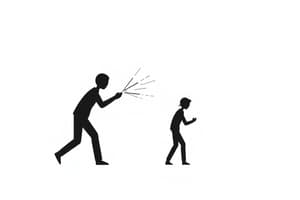Podcast
Questions and Answers
Quel est le problème causé par une sous-activation?
Quel est le problème causé par une sous-activation?
- Rétrécissement du champ attentionnel
- Performance optimale
- Contrôle d'exécution fin
- Champ attentionnel trop grand (correct)
Un rétrécissement trop important du champ attentionnel est lié à la sous-activation.
Un rétrécissement trop important du champ attentionnel est lié à la sous-activation.
False (B)
Quel est le rôle de l'entraîneur en psychologie du sport?
Quel est le rôle de l'entraîneur en psychologie du sport?
Amener l'athlète à un niveau d'activation optimal
Le champ attentionnel trop grand causé par une sous-activation peut mener à une __________.
Le champ attentionnel trop grand causé par une sous-activation peut mener à une __________.
Associez les termes aux bonnes descriptions.
Associez les termes aux bonnes descriptions.
Quel est l'état d'éveil?
Quel est l'état d'éveil?
Le niveau d'activation reste constant indépendamment de la motivation et du stress.
Le niveau d'activation reste constant indépendamment de la motivation et du stress.
Quels sont deux facteurs qui peuvent influencer le niveau d'activation?
Quels sont deux facteurs qui peuvent influencer le niveau d'activation?
Le ______ est un psychostimulant qui peut améliorer l'éveil.
Le ______ est un psychostimulant qui peut améliorer l'éveil.
Quelle molécule est connue pour stimuler la vigilance?
Quelle molécule est connue pour stimuler la vigilance?
Un désavantage potentiel d'une période sans sommeil est une diminution de la vigilance.
Un désavantage potentiel d'une période sans sommeil est une diminution de la vigilance.
Associez les éléments suivants avec leur effet sur l'éveil:
Associez les éléments suivants avec leur effet sur l'éveil:
Un problème de la vie quotidienne peut être affecté par le niveau d'______.
Un problème de la vie quotidienne peut être affecté par le niveau d'______.
Quel est le seuil de détection ou de reconnaissance selon la courbe de détection des stimuli?
Quel est le seuil de détection ou de reconnaissance selon la courbe de détection des stimuli?
La détection des stimuli est toujours affectée par le bruit ambiant.
La détection des stimuli est toujours affectée par le bruit ambiant.
À quel niveau d'activation augmente la probabilité de détection d'un stimulus?
À quel niveau d'activation augmente la probabilité de détection d'un stimulus?
La détection est plus facile lorsque l'intensité du stimulus est __________.
La détection est plus facile lorsque l'intensité du stimulus est __________.
Associez les éléments suivants à leur description:
Associez les éléments suivants à leur description:
Quel est l'impact d'un stimulus faible sur la détection?
Quel est l'impact d'un stimulus faible sur la détection?
La courbe de bruit et la courbe de signal sont identiques.
La courbe de bruit et la courbe de signal sont identiques.
Qu'est-ce qui affecte notre capacité à détecter un stimulus selon les études psychophysiques?
Qu'est-ce qui affecte notre capacité à détecter un stimulus selon les études psychophysiques?
Quel facteur influence la facilité de détection d'un stimulus?
Quel facteur influence la facilité de détection d'un stimulus?
L'intensité du bruit n'influence pas la détection des stimuli.
L'intensité du bruit n'influence pas la détection des stimuli.
Comment se nomme la relation entre le niveau d'activation perçu et l'intensité du stimulus?
Comment se nomme la relation entre le niveau d'activation perçu et l'intensité du stimulus?
Lorsque l'intensité du stimulus est X, la courbe représente _____ du signal.
Lorsque l'intensité du stimulus est X, la courbe représente _____ du signal.
Que se passe-t-il lorsque l'intensité du stimulus augmente?
Que se passe-t-il lorsque l'intensité du stimulus augmente?
Associez les termes suivants avec leurs significations:
Associez les termes suivants avec leurs significations:
L'activation perçue dépend uniquement du bruit environnant.
L'activation perçue dépend uniquement du bruit environnant.
Quel rôle joue le bruit dans la perception des stimuli?
Quel rôle joue le bruit dans la perception des stimuli?
Quelle est la conséquence des faux rejets dans le système de notation?
Quelle est la conséquence des faux rejets dans le système de notation?
Un expert en sport a moins d'erreurs de prédiction qu'un novice.
Un expert en sport a moins d'erreurs de prédiction qu'un novice.
Quelle étude a été citée pour examiner l'origine du signal dans le contexte sportif?
Quelle étude a été citée pour examiner l'origine du signal dans le contexte sportif?
Dans une étude de lancer-franc au basket-ball, ______% des lancers sont « in » et ______% sont « out ».
Dans une étude de lancer-franc au basket-ball, ______% des lancers sont « in » et ______% sont « out ».
Associez les différents groupes de participants à leurs désignations:
Associez les différents groupes de participants à leurs désignations:
Quel est le rôle des jugements comparatifs dans l'étude psychophysique?
Quel est le rôle des jugements comparatifs dans l'étude psychophysique?
Les jugements comparatifs ne peuvent être réalisés qu'avec des images.
Les jugements comparatifs ne peuvent être réalisés qu'avec des images.
Comment l'expertise influence-t-elle l'activation perçue lors de la détection de signaux?
Comment l'expertise influence-t-elle l'activation perçue lors de la détection de signaux?
Quel terme désigne une réponse correcte à un stimulus?
Quel terme désigne une réponse correcte à un stimulus?
Un expert a une courbe de bruit plus élevée que celle d'un débutant.
Un expert a une courbe de bruit plus élevée que celle d'un débutant.
Qu'est-ce qu'une fausse alarme?
Qu'est-ce qu'une fausse alarme?
Le coût d'un ________ est généralement élevé pour l'analyse des signaux.
Le coût d'un ________ est généralement élevé pour l'analyse des signaux.
Associez les termes suivants aux descriptions appropriées :
Associez les termes suivants aux descriptions appropriées :
Quel est le rôle du critère de décision C?
Quel est le rôle du critère de décision C?
Le critère de décision reste fixe indépendamment de la situation.
Le critère de décision reste fixe indépendamment de la situation.
Quelle est la probabilité de faux rejets si le signal est présent dans 90% des cas?
Quelle est la probabilité de faux rejets si le signal est présent dans 90% des cas?
Un expert est plus habile car il peut mieux ________ son critère.
Un expert est plus habile car il peut mieux ________ son critère.
Associez les types de réponses aux conséquences d'une détection de stimulus :
Associez les types de réponses aux conséquences d'une détection de stimulus :
Comment la probabilité d'occurrence influence-t-elle la détection des stimuli?
Comment la probabilité d'occurrence influence-t-elle la détection des stimuli?
Le rejet correct est considéré comme 'payant' dans la détection des stimuli.
Le rejet correct est considéré comme 'payant' dans la détection des stimuli.
Quel est l'impact d'une courbe de bruit élevée?
Quel est l'impact d'une courbe de bruit élevée?
Une détection efficace repose sur un bon équilibre entre _______ et _______.
Une détection efficace repose sur un bon équilibre entre _______ et _______.
Flashcards
Optimal activation
Optimal activation
A level of arousal where performance is at its best.
Underactivation
Underactivation
A state of arousal where attention span is too broad, leading to distractions.
Overactivation
Overactivation
Excessive arousal leading to a narrow, overly focused attention span.
Performance
Performance
Signup and view all the flashcards
Perceptual limits
Perceptual limits
Signup and view all the flashcards
Optimal Alertness
Optimal Alertness
Signup and view all the flashcards
Level of Activation
Level of Activation
Signup and view all the flashcards
Performance
Performance
Signup and view all the flashcards
Motivation
Motivation
Signup and view all the flashcards
Workload
Workload
Signup and view all the flashcards
Fatigue
Fatigue
Signup and view all the flashcards
Stress
Stress
Signup and view all the flashcards
Daily Life Problem
Daily Life Problem
Signup and view all the flashcards
Signal Detection
Signal Detection
Signup and view all the flashcards
Noise
Noise
Signup and view all the flashcards
Activation Curve (Background Noise)
Activation Curve (Background Noise)
Signup and view all the flashcards
Threshold of Detection
Threshold of Detection
Signup and view all the flashcards
Stimulus Intensity & Detection
Stimulus Intensity & Detection
Signup and view all the flashcards
Optimal Activation
Optimal Activation
Signup and view all the flashcards
Signal Detection Curves (Signal)
Signal Detection Curves (Signal)
Signup and view all the flashcards
50% Correct
50% Correct
Signup and view all the flashcards
Signal Detection
Signal Detection
Signup and view all the flashcards
Stimulus Intensity
Stimulus Intensity
Signup and view all the flashcards
Noise Curve
Noise Curve
Signup and view all the flashcards
Signal Curve
Signal Curve
Signup and view all the flashcards
Activation Level
Activation Level
Signup and view all the flashcards
Stimulus Detection
Stimulus Detection
Signup and view all the flashcards
Perceived Activation
Perceived Activation
Signup and view all the flashcards
Source of activation
Source of activation
Signup and view all the flashcards
Hit
Hit
Signup and view all the flashcards
False Alarm
False Alarm
Signup and view all the flashcards
Correct Rejection
Correct Rejection
Signup and view all the flashcards
Miss
Miss
Signup and view all the flashcards
Criterion (C)
Criterion (C)
Signup and view all the flashcards
Signal Detection Theory
Signal Detection Theory
Signup and view all the flashcards
Stimulus Intensity
Stimulus Intensity
Signup and view all the flashcards
Noise
Noise
Signup and view all the flashcards
Expert vs. Beginner
Expert vs. Beginner
Signup and view all the flashcards
Decision Criterion
Decision Criterion
Signup and view all the flashcards
Probability of Signal
Probability of Signal
Signup and view all the flashcards
Cost/Benefit
Cost/Benefit
Signup and view all the flashcards
Perceived Activation Level
Perceived Activation Level
Signup and view all the flashcards
Curve of Signal
Curve of Signal
Signup and view all the flashcards
Curve of Noise
Curve of Noise
Signup and view all the flashcards
Signal Detection Theory
Signal Detection Theory
Signup and view all the flashcards
Hit/False Alarm
Hit/False Alarm
Signup and view all the flashcards
Expert vs. Novice
Expert vs. Novice
Signup and view all the flashcards
Signal Masking
Signal Masking
Signup and view all the flashcards
Comparative Judgments
Comparative Judgments
Signup and view all the flashcards
Psychophysics
Psychophysics
Signup and view all the flashcards
Detection in Sports
Detection in Sports
Signup and view all the flashcards
Predicting Success
Predicting Success
Signup and view all the flashcards
Study Notes
Apprentissage moteur et performance du mouvement humain (Kin-1031) - Chapitre 5
- Le chapitre explore l'apprentissage moteur et la performance du mouvement humain.
- Le chapitre 5 est une partie du cours Kin-1031.
L'attention (éveil)
- L'éveil est la capacité d'atteindre et de maintenir un niveau optimal d'alerte.
- Le système nerveux central (SNC) est prêt à recevoir et traiter les stimuli à une vitesse optimale.
- La performance est liée au niveau d'activation. Il existe un niveau optimal d'activation, qui détermine la performance.
- Le niveau d'activation fluctue en fonction de la motivation, de la charge de travail, de la fatigue et du stress.
Effets des stimulants sur la vigilance
- La dextroamphétamine (Dexedrine) et le modafinil (Alertec) sont des stimulants.
- Ces médicaments peuvent améliorer la performance des tests de vigilance psychomotrice après 44 heures de veille continue.
- La caféine est un stimulant qui a été étudié en rapport avec la vigilance psychomotrice.
La détection des stimuli
- La probabilité d'une détection correcte d'un stimulus dépend de l'intensité du stimulus.
- Des seuils de détection/reconnaissance peuvent être déterminés comme une probabilité de 50% d'une détection correcte basée sur l'intensité du stimulus.
- Au-delà du seuil, la probabilité d'une bonne détection correcte du stimulus augmente.
- Le bruit et/ou l'état d'activation de l'individu influencent la détection des stimuli.
- La courbe de bruit est importante dans la détermination du seuil de détection.
- L'expert est capable de mieux filtrer le bruit.
Jugement absolu/Comparatif
- Les jugements absolus impliquent l'utilisation d'un standard de référence en mémoire.
- Les jugements comparatifs concernent la détection des similitudes ou différences entre les stimuli.
- La loi de Weber décrit la relation entre la différence d'intensité d'un stimulus et la capacité de l'individu à la percevoir.
- La «loi de Weber» est un outil calculé qui quantifie la précision dans la perception d'une différence.
Studying That Suits You
Use AI to generate personalized quizzes and flashcards to suit your learning preferences.




